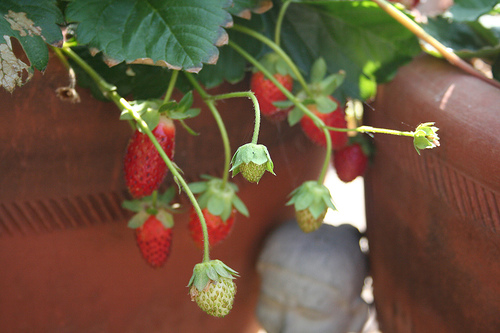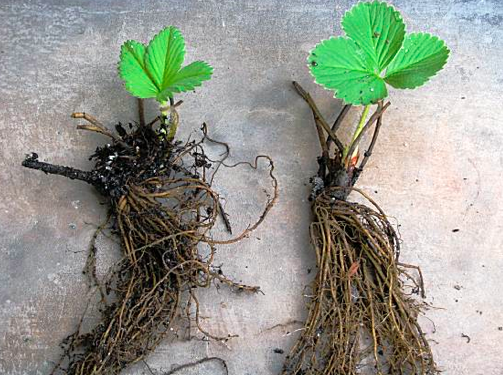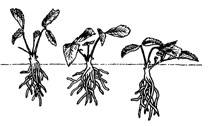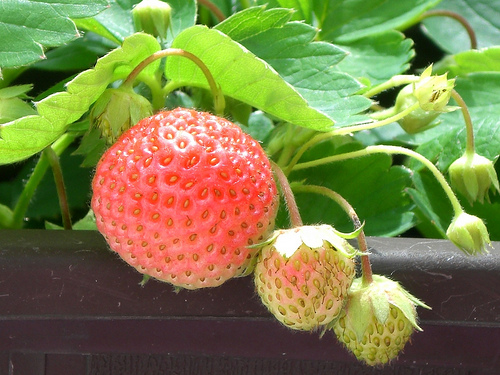Here’s almost everything you need to know about growing strawberries:
- They like sun.
- They like to be watered regularly, but they don’t want to be soggy.
Ta da! Buy a strawberry plant, put it in a pot with good drainage, pop it in a sunny corner, and you’re done. Should you have slightly more curiosity than that, however, there are perhaps a few other things to know.

Just a hint of the fun that can be yours if you spend time researching strawberry cultivars (via Institute for Food and Agricultural Sciences)
Let’s start with picking your plant. Strawberry plants fall into three broad categories: “June bearing,” “Day neutral” and “Ever bearing.”
Based on name alone, Ever bearing sounds like the jackpot, doesn’t it? Turns out, the name is a little bit of a fake out. Day neutral strawberries are actually the ones that bear fruit throughout the growing season. Ever bearing strawberries, on the other hand, give you three discreet crops, one in spring, one in summer, and one in fall.
And what about June bearing? Self-explanatory, and also a little sad? I mean, why have just one month of strawberries when you could have them all summer? But here’s the trick for June bearing varieties: for that one month, you’re in strawberry heaven. June bearing strawberries typically grow tons of fruit and put out lots of runners, meaning new growth that helps the plants spread. Basically, they’re going to give you that gangbusters “look at my strawberries!” feeling. Day neutral and Ever bearing don’t spread as vigorously, which is fine, just worth noting. Not like the fruit isn’t still great. All things considered, I myself enjoy a June bearing plant.
Once you’ve picked a type, you can then read up on particular strawberry cultivars within that type. Though if you’re not studying to be a professional strawberry farmer, that may make your eyes glaze over. I suggest just picking a broad type and winging it a little from there.
Next up, let’s talk about planting details. Strawberry plants are sold two ways: bare root and potted. If you buy a potted plant, it’s easy. Just re-pot it like you would any other plant (though don’t bury the crown — what’s that? We’ll get there in a minute). Bare root is slightly more complicated, but not really. If it’s more complicated at all, though, why would you buy them? Well, because you usually get more plants at a lower cost. Here’s what bare root strawberry plants look like:
When you buy bare root strawberry plants, you’ll get a bundle of plants, maybe six to eight (maybe more!) all rubber banded together. Just undo the rubber band, and lay them out on a table. They’re not tricky to pull apart or anything. Right away, you’ll see the individual plants. Then, you just have to put them in soil. Here’s where we get to the issue of the crown.
In the picture above, see the dark part that’s above the hairy roots but below the green shoots? That’s the crown. Strawberries like for their crown to be above ground. The handy illustration at left shows you the ideal planting depth. The plant in the middle is the winner — the roots aren’t hanging out and the crown isn’t smothered. Perfect. Whether you’re planting bare root strawberry plants or re-potting already potted strawberry plants, same rule applies: don’t bury the crown.
So, what’s the right time for all this planting? Strawberries can be planted early, as soon as the danger of frost has passed (or even earlier if you’re willing to open the window to the fire escape and throw a blanket over the plants when the temperature dips). If you’re getting started a little later (say…now), that’s okay too. But opt for an Ever bearing or a Day neutral variety, since that whole June thing is pretty much past tense.
Strawberries are perennials, meaning if you treat them right, they’ll pop back up again next year. That’s easier said than done in containers, though (being above ground makes winter conditions harsher). So you’ll probably want to treat them as an annual and start again with new plants next year.
Finally, and perhaps most importantly, there’s harvesting your strawberries. Unlike many other fruits, strawberries won’t sweeten up once they’ve been pulled from the plant. They’ll get redder, but they won’t otherwise get riper. So wait till they’re fully red before plucking them, otherwise you’ll have some tart strawberries on your hands. Which certainly isn’t the worst thing. There’s always the strawberry cake solution.




this interesting, but i would like to know how to plant a potted strawberry plant.someone help me!
Replanting potted strawberry plants — totally doable! Lift the plant and the soil gently from the pot (they should come out sort of like a popsicle) than plop them down on top of the new soil in the new pot (or dirt outside, if you’re planting outdoors). Just like in the post, you want the soil to cover the roots but not the crown, so fill in the new pot with enough soil to lift the plant to the right level and, voila! Hope that helps! Give a holler if you need more pointers.
how many times a day should i water them??
They only need to be watered a couple of times a week. Unless it’s the peak of summer and they’re getting a lot of direct sunlight, in which case the soil dries out faster and you may need to water them every other day or even every day (you’ll be able to tell if they’re dry because they’ll wilt. If so, just up your watering).